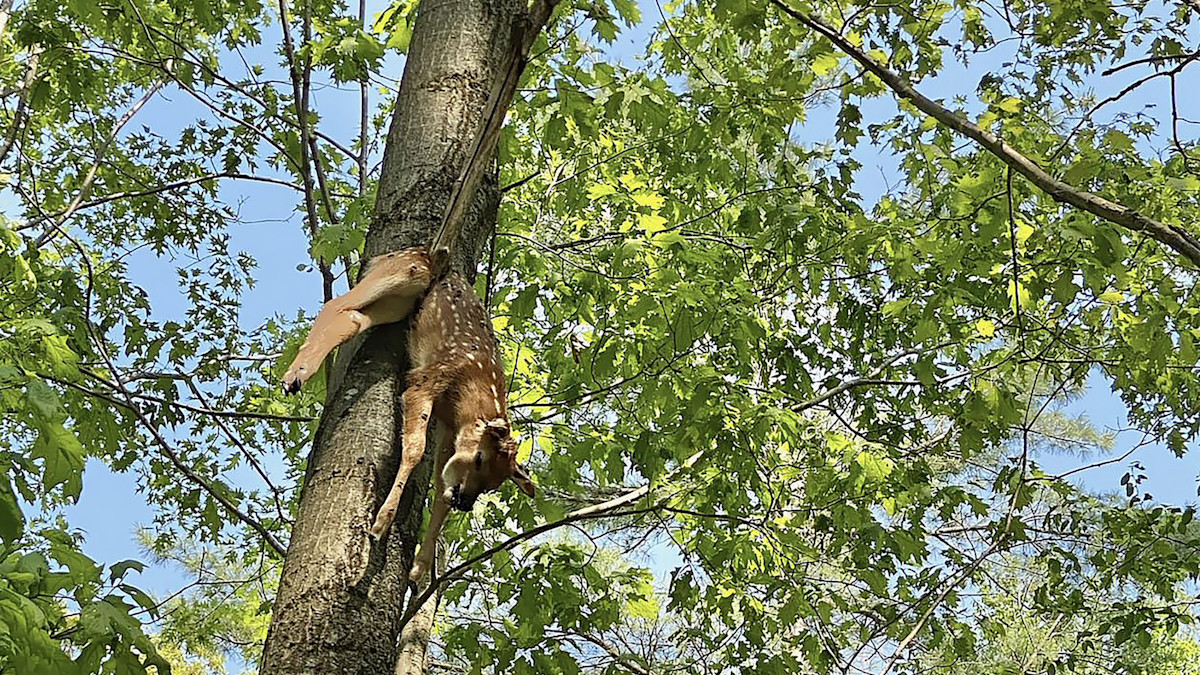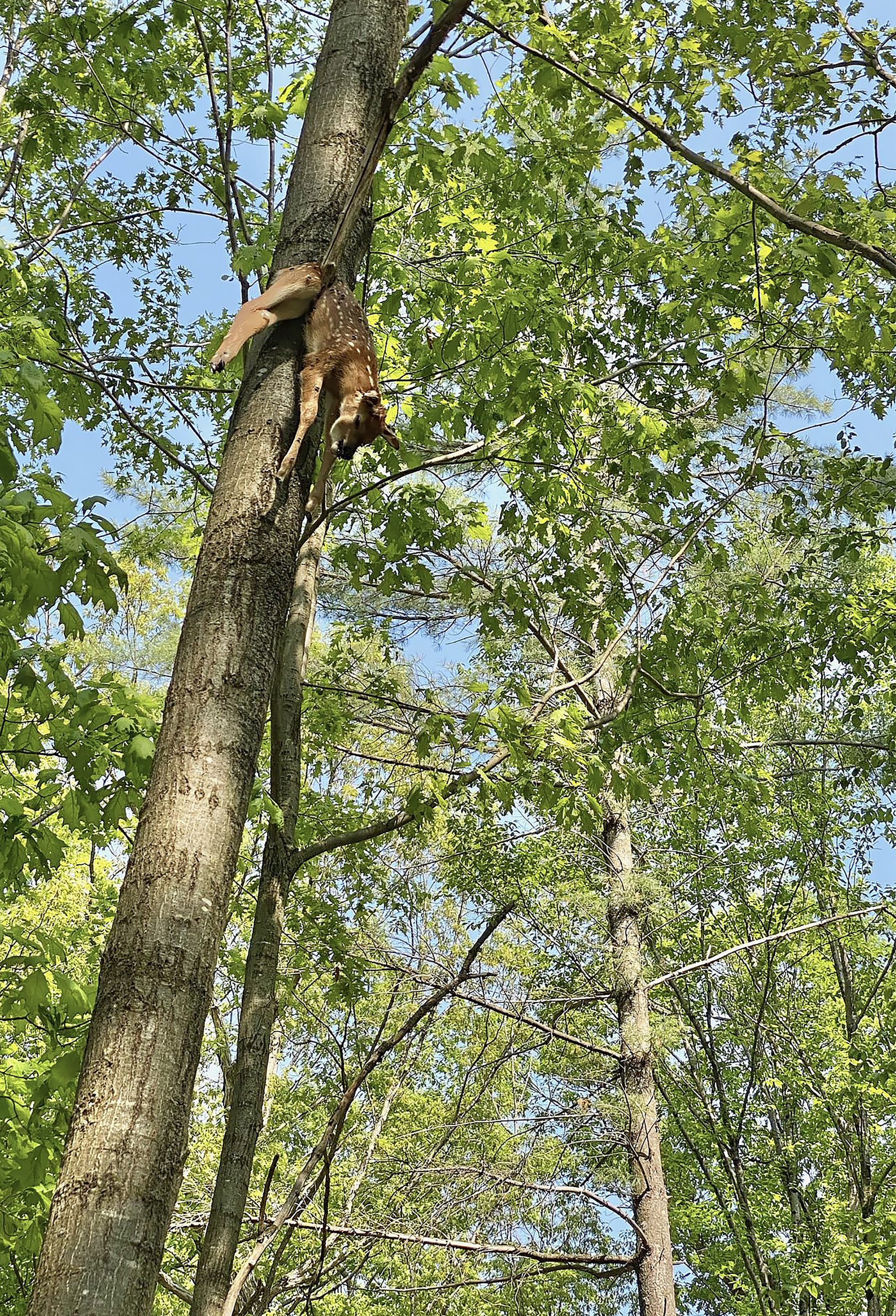
Jerry Hamm easily explains how he happened to see a dead whitetail fawn hanging upside down 15 feet up a red oak, its hips wedged into the tree’s first crotch.
Hamm made the discovery on May 20 while walking through his 34-acre property located four miles north of Neillsville in central Wisconsin.
“If you love trees as much as I do, especially red oaks and white oaks that make good veneer logs, you’re always looking up into trees,” said Hamm, a member of the Wisconsin Woodlands Owners Association. “But that’s the first time I’ve seen a deer up a tree, and I haven’t spoken to anyone since who’s seen one, either.”
Hamm said he photographed a newborn fawn nearby the day before and assumed it was the same deer. He also keeps two trail cameras on his property, which occasionally capture photographs of bobcats. But when he examined the bark on the 10-inch diameter gallows oak, he didn’t find obvious claw marks from a bear or bobcat.
Hamm photographed the death scene and set up a trail cam to monitor the site, but nothing returned to claim the corpse. He emailed the photo to some friends and asked, “I’m wondering if it was an eagle, or perhaps a fisher?”
After looking at Hamm’s photos and notes, I sent everything to some bird and wildlife experts who often solve nature’s mysteries. This list included retired professors Scott Craven and Stanley Temple at the University of Wisconsin-Madison; Ryan Brady, a Wisconsin Department of Natural Resources (DNR) ornithologist; Randy Johnson, the DNR’s large-carnivore specialist; and Keith Warnke, a retired DNR biologist whose expertise is raptors.
“Was there an eagle’s nest higher up the tree or a nearby tree?” Warnke asked.
There was not.
Forced to speculate with only the photo and Hamm’s note, even these experts were puzzled. Bears and bobcats rarely cache food in trees, and no two-pound weasel—a species well-known for caching food—can fireman-carry an eight-pound fawn 15 feet up a slick-barked red oak.
In contrast, bald eagles sometimes fly off with newborn fawns, given the right conditions. But no eagle would purposely drop food into an oak’s crotch where it couldn’t retrieve it or return to eat. Here are some quotes from my experts:
“Beats me,” Brady replied. “I’d vote mammalian predator, but not sure, of course.”
Johnson wrote: “I have a hard time picturing a bear or bobcat caching a fawn way up there. A bear could consume a fawn in one sitting, so why not just eat it? A bobcat is more inclined to cache, but it would most likely cache it on the ground. That’s also not a good climbing tree for either species. And with no claw marks on the tree, I speculate it’s avian.”
Craven agreed: “I’d go with leopard, but then realized we’re in Wisconsin. I agree with [Johnson’s] reasoning on bear and bobcat. Removing all the canids (fox, coyote, wolf) doesn’t leave many mammalian options.”
Temple also felt stumped, but thinks it’s an eagle. “A bald eagle carrying a scavenged dead fawn would be a good guess,” he wrote. “Fawns weigh six to eight pounds at birth, which an adult bald eagle can lift and fly with if conditions are right. (They’d need) a lifting wind, a dead—not struggling—fawn that they grabbed and lifted while flying; so they’d have momentum, and not be deadlifting. Too bad the nice meal ended up where it couldn’t be retrieved. My guess is that an eagle lost control of the carcass while flying, and it fell and wedged into the crotch.”
Warnke then called to say: “During my graduate work 30 years ago monitoring bald eagles, one of my cameras recorded an eagle delivering a dead fawn to the nest and feeding it to its nestlings. The eagles mostly brought easily accessible fish like carp, bullheads, suckers, and northern pike, but they also flew in with ducks, seagulls, and cormorants. One eagle even brought back a housecat. Eagles are opportunistic predators and scavengers, and they constantly steal fish from ospreys. They’ll take an easy meal every time, but when they want to be predators, they’re very good at it.”
Meanwhile, Hamm tracked down a fellow Neillsville resident to help. Steve Meurett is a biologist who helps manage the DNR’s “Snapshot Wisconsin” program, a project that collects and identifies wildlife photos taken by citizen-monitored trail cams statewide.
Hamm took Meurett to the site a few days later. Upon close inspection, Meurett found light scratch marks on the oak, and noted a three-inch spread between toe claws. More telling, he and Hamm also found hard-to-see white belly hairs, apparently the fawn’s, on the ground and wedged beneath the bark’s underside.
“The claw marks were about head high, with a few higher up the tree,” Meurett said. “They were narrow, sharp, and fresh. I think a large bobcat made them. The white belly hair under the bark answered things. Something carried that fawn up the tree, but why? I can only speculate.”
With that, Meurett speculated.
“Something made that bobcat do something it wouldn’t normally do,” he said. “Maybe some coyotes were nearby, and the bobcat needed to get its kill off the ground right away. I doubt a lone coyote would challenge a mature bobcat because they’re tough. But two or more coyotes might have a chance of running it off or grabbing the fawn.”
But why didn’t the bobcat return for its kill?
More speculation: Maybe it tried before Hamm showed up, but couldn’t dislodge it. Or maybe the coyote encounter was enough of an ordeal to discourage the bobcat’s return. Or maybe it returned but coyotes drove it off a second time.
Temple, however, stood firm. “Hair evidence notwithstanding, l’m sticking with a bald eagle. I can find no records of bobcats caching prey of any kind in trees, let alone one as heavy as a fawn.”
Feel free to speculate, folks.

Image via Steve Meurett.



